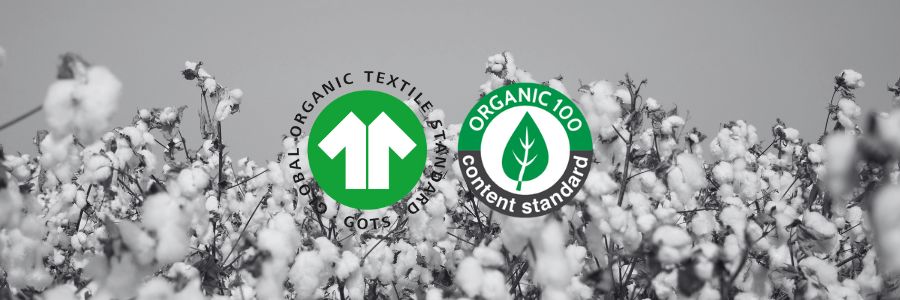Organic cotton is growing rapidly in popularity. Just look at this graph.

When I started Ruler of London, I knew I wanted to use organic cotton in our clothing, but I'm ashamed to say I didn't know that much about it. ‘Organic’ is one of those words like ‘world-class’ or ‘literally’ - often overused, rarely understood.
What does organic cotton even mean? Is it worth it? I read thousands of words about fertiliser, pesticides, water usage, GOTS certification, and Turkish farming practices so you don't have to.
What is organic cotton?
Organic cotton is cotton grown without artificial pesticides, artificial fertilisers, or genetically modified seeds. It tends to be more expensive, but better for the environment.
Artificial pesticides and fertilisers are widely used in standard agriculture. These chemicals can be pretty bad for the planet. They run into the groundwater, create dead zones in lakes and the ocean, kill wildlife, and release greenhouse gases.
The organic cotton movement aims to solve this problem, by rewarding farmers to switch to organic production methods, which rely on natural techniques like animal manure.
It takes about three years for farmers to change over, during which time their cotton is known as ‘in-conversion organic cotton’. This was 34% of organic cotton at the last data available in 2022, so it's not insignificant.
The environmental impact of organic cotton
There are certainly benefits to organic cotton. Primarily, organic farming avoids synthetic pesticides and fertilisers.
Synthetic pesticides are good for protecting crops, but they’re toxic to lots of other wildlife as well, including human beings. Roughly 55% carry environmental or health warnings, according to this report.
Synthetic fertilisers are miraculous for crop yields, however they leach into the water system and overstimulate algae, which then kills everything else (remember eutrophication from school?). There's a great article from Mongabay which explains it well.
There is also the question of water usage. Cotton is widely cited as a ‘thirsty crop' (although this is disputed). Organic cotton is said to use less water, but again, this is unclear. Much of this seems to stem from a report in 2014, which claimed that organic cotton used 91% less water. However, this report was largely comparing small organic farms (which are watered by rain) with big traditional farms that are irrigated using ‘blue water’ from aquifers and lakes. Don't trust the 91% claim.
Interestingly I also found people who claim organic cotton actually uses more water, and could therefore be just as bad for the environment as normal cotton. This is because organic cotton uses more land per bale of cotton. No-one seems sure, but what is certain is that organic cotton does not require the same sort of harmful chemicals as conventional cotton.
How can you tell if it's really organic cotton?
There are two main accreditation bodies: GOTS and OCS.

GOTS stands for Global Organic Textile Standard. They're an organisation based in Germany who accredit cotton producers and manufacturers to make sure they're meeting organic standards. The standards are very comprehensive (you can find the full list here) but essentially it prohibits lots of chemicals and genetic modification. It costs money to join GOTS, as they will undertake inspections of members to make sure they comply. There are tons more details on their FAQ page here.
OCS stands for Organic Content Standard and is issued by the Textile Exchange. They focus more on production standards, whereas GOTS has additional standards through the processing stages. I found it more difficult to find a complete list of banned chemicals, but you can find a full list of their resources here and their FAQs here.
If you want to buy organic cotton as a consumer in the UK, you'd generally see the GOTS logo. However that doesn't mean that all organic cotton is GOTS certified (our own organic cotton does not come with GOTS certification, as it would have cost an additional fee, plus a charge per garment).
Top producers of organic cotton in the World
- The number 1 producer of organic cotton is India at 38%
- The number 2 producer of organic cotton is Turkey at 24%
- The number 3 producer of organic cotton is China at 10%
This is the data as of 2022, and is taken from the Textile Exchange Organic Cotton Market Report (very well produced, have a look here for the report in full). You can see the full chart here:

What’s interesting (and very honest) about the Textile Exchange’s report is how they report data confidence. Basically, none of it is very confident at all. The reality of tracking cotton production across vast countries like India means there will always be some gaps.
Trends in organic cotton growth
Some other points of note in the Textile Exchange report:
- Global Organic Cotton production grew by 37% from 2020 to 2021
- Turkey was the fastest growing producer at 233%
- Kazakhstan went from nothing to the 7th largest producer in one year, overtaking the US
- Only 1.4% of global cotton is organic
Why does organic cotton cost more?
It has lower yield. Yield is defined as production per hectare. Organic cotton is more difficult to produce, and that means you get less of it per unit of land.
Roughly 28% less, according to the New York Times. However, I would say that I found so many figures claiming to show the yield deficit of organic cotton that I would take this with a pinch of salt.
I also found some which said organic cotton was higher yield than conventional cotton, although I'd take this with a huge saltmine of salt. If organic cotton really did have higher yields, much more than 1.4% of farmers would already be growing it.
Is organic cotton softer?
No. It is just produced in a different way. Softer cotton tends to be long fibre cotton, such as Supima, and is a different thing.

